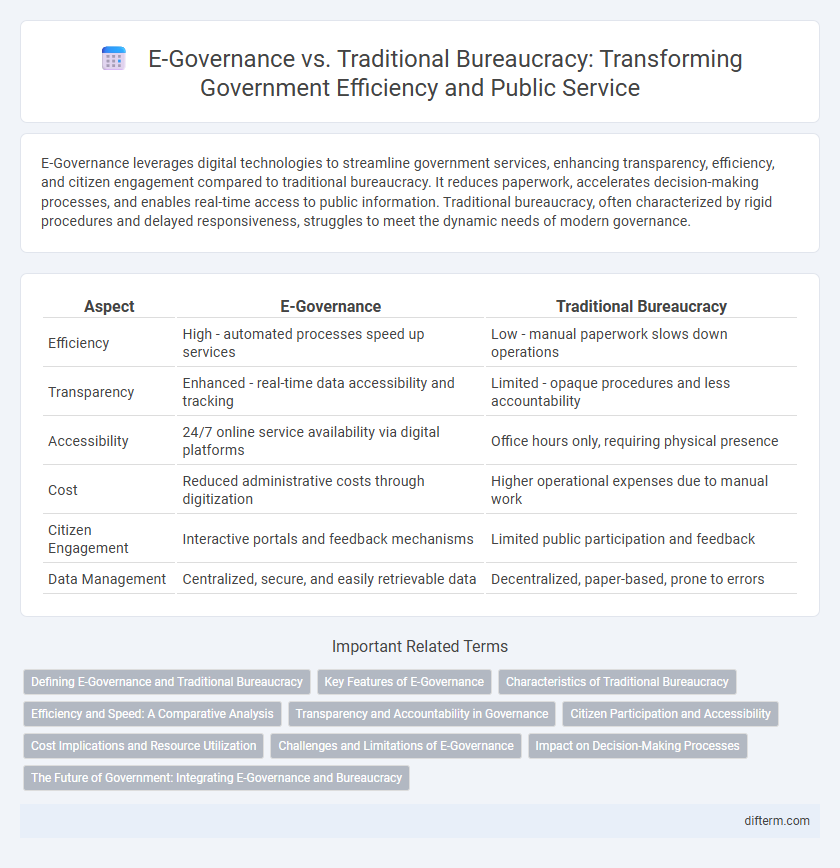E-Governance leverages digital technologies to streamline government services, enhancing transparency, efficiency, and citizen engagement compared to traditional bureaucracy. It reduces paperwork, accelerates decision-making processes, and enables real-time access to public information. Traditional bureaucracy, often characterized by rigid procedures and delayed responsiveness, struggles to meet the dynamic needs of modern governance.
Table of Comparison
| Aspect | E-Governance | Traditional Bureaucracy |
|---|---|---|
| Efficiency | High - automated processes speed up services | Low - manual paperwork slows down operations |
| Transparency | Enhanced - real-time data accessibility and tracking | Limited - opaque procedures and less accountability |
| Accessibility | 24/7 online service availability via digital platforms | Office hours only, requiring physical presence |
| Cost | Reduced administrative costs through digitization | Higher operational expenses due to manual work |
| Citizen Engagement | Interactive portals and feedback mechanisms | Limited public participation and feedback |
| Data Management | Centralized, secure, and easily retrievable data | Decentralized, paper-based, prone to errors |
Defining E-Governance and Traditional Bureaucracy
E-Governance utilizes digital technologies to deliver government services efficiently, promoting transparency, accountability, and citizen participation. Traditional bureaucracy relies on hierarchical structures and manual processes, often resulting in slower decision-making and limited public accessibility. The shift from traditional bureaucracy to e-governance aims to enhance administrative efficiency and foster a more responsive government ecosystem.
Key Features of E-Governance
E-Governance leverages digital technologies to enhance transparency, efficiency, and citizen engagement by enabling online service delivery, real-time data management, and automated processes. It prioritizes interoperability, secure data exchange, and user-centric portals that reduce paperwork and bureaucratic delays. Key features include electronic voting, digital identity authentication, mobile accessibility, and continuous feedback mechanisms to drive responsive governance.
Characteristics of Traditional Bureaucracy
Traditional bureaucracy in government is characterized by hierarchical structures, rigid procedures, and centralized decision-making processes that emphasize rule-based operations and formal communication channels. It relies on standardized regulations and extensive paperwork, often leading to slower service delivery and limited transparency. This model values stability and predictability but frequently struggles with inefficiency and reduced citizen engagement compared to e-governance systems.
Efficiency and Speed: A Comparative Analysis
E-Governance streamlines administrative processes through digital platforms, significantly reducing paperwork and processing times compared to traditional bureaucracy. By leveraging automation and real-time data access, e-governance enhances decision-making speed and minimizes human errors, leading to greater operational efficiency. Traditional bureaucracy, often characterized by hierarchical structures and manual procedures, struggles with delays and inefficiencies, limiting timely public service delivery.
Transparency and Accountability in Governance
E-Governance enhances transparency by digitizing government processes, enabling real-time public access to information and reducing opportunities for corruption. Traditional bureaucracy often suffers from opaque procedures and limited accountability due to paper-based records and hierarchical bottlenecks. Implementing e-governance frameworks fosters greater public trust and efficient monitoring of governmental actions through automated audits and transparent reporting systems.
Citizen Participation and Accessibility
E-Governance significantly enhances citizen participation by providing digital platforms that enable real-time feedback, transparent access to government services, and streamlined communication channels. Unlike traditional bureaucracy, which often faces challenges of limited accessibility due to physical office hours and location constraints, e-governance integrates mobile applications and online portals to ensure 24/7 availability and inclusiveness for diverse populations. This digital transformation reduces administrative bottlenecks and empowers citizens with more direct involvement in policy-making and service delivery processes.
Cost Implications and Resource Utilization
E-Governance significantly reduces operational costs by minimizing paperwork, streamlining service delivery, and enhancing transparency compared to traditional bureaucracy. It optimizes resource utilization through automated workflows and digital infrastructure, leading to faster decision-making and reduced redundancies. Traditional bureaucracy often incurs higher expenses due to manual processes, physical offices, and prolonged administrative procedures, resulting in inefficient resource allocation.
Challenges and Limitations of E-Governance
E-Governance faces significant challenges such as digital divide, cybersecurity threats, and limited infrastructure, which hinder equitable access and data protection. Traditional bureaucracy struggles with inefficiencies and slower service delivery, but benefits from structured accountability and established legal frameworks. Integrating E-Governance requires overcoming resistance to change, ensuring digital literacy, and developing robust policy frameworks to mitigate security risks.
Impact on Decision-Making Processes
E-Governance leverages digital platforms to streamline decision-making processes, resulting in faster data access, increased transparency, and improved citizen participation compared to traditional bureaucracy. Traditional bureaucracy often involves hierarchical structures and manual procedures that slow down decision-making and limit real-time information flow. The integration of e-governance tools enhances efficiency, reduces corruption risks, and enables evidence-based policymaking within government institutions.
The Future of Government: Integrating E-Governance and Bureaucracy
Integrating e-governance with traditional bureaucracy enhances government efficiency by digitizing administrative processes while retaining institutional accountability. Leveraging advanced technologies like AI and blockchain ensures transparent, secure public service delivery, reducing delays and corruption. This hybrid approach supports adaptive governance models that meet evolving citizen needs and promote sustainable development.
E-Governance vs Traditional Bureaucracy Infographic

 difterm.com
difterm.com